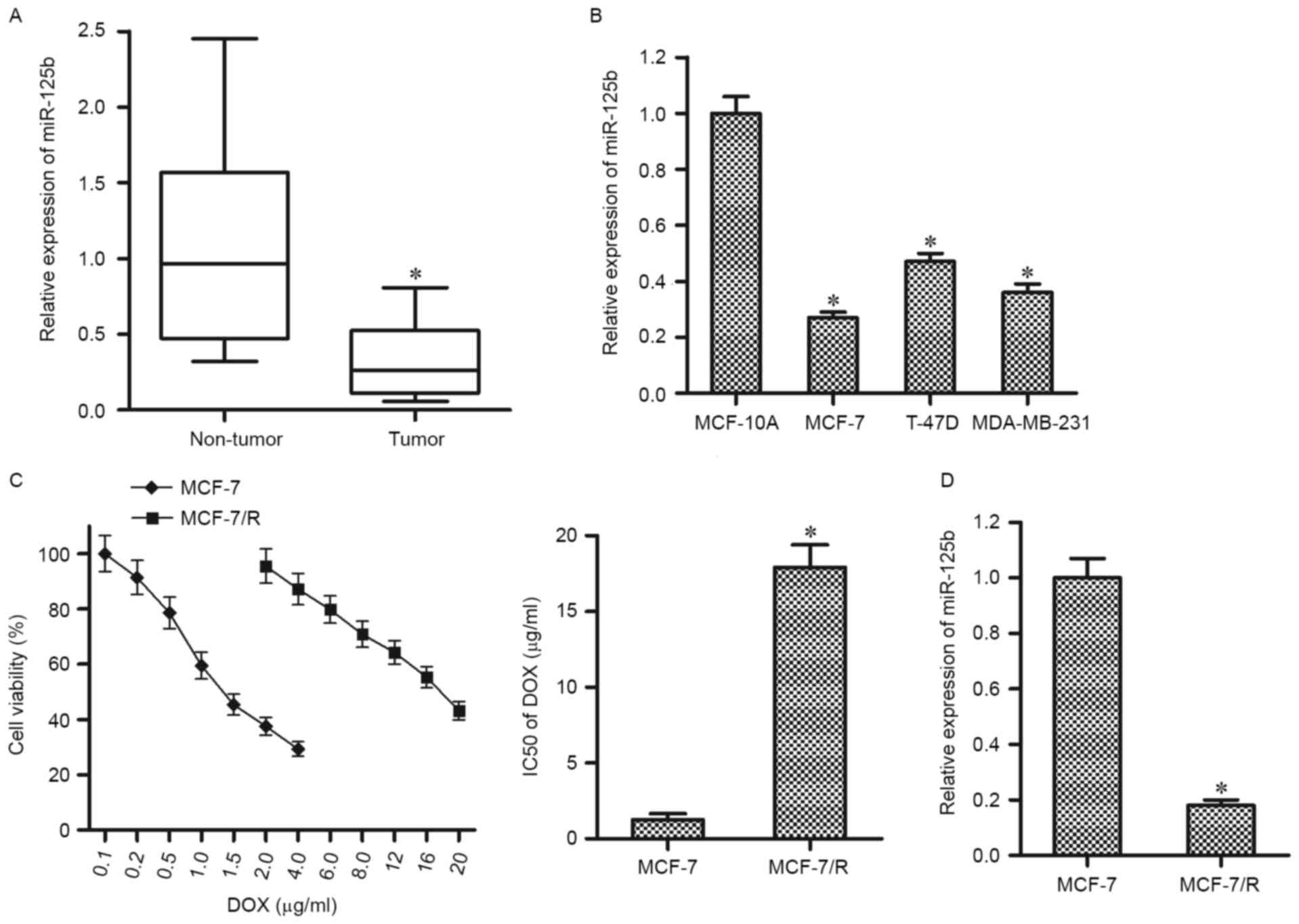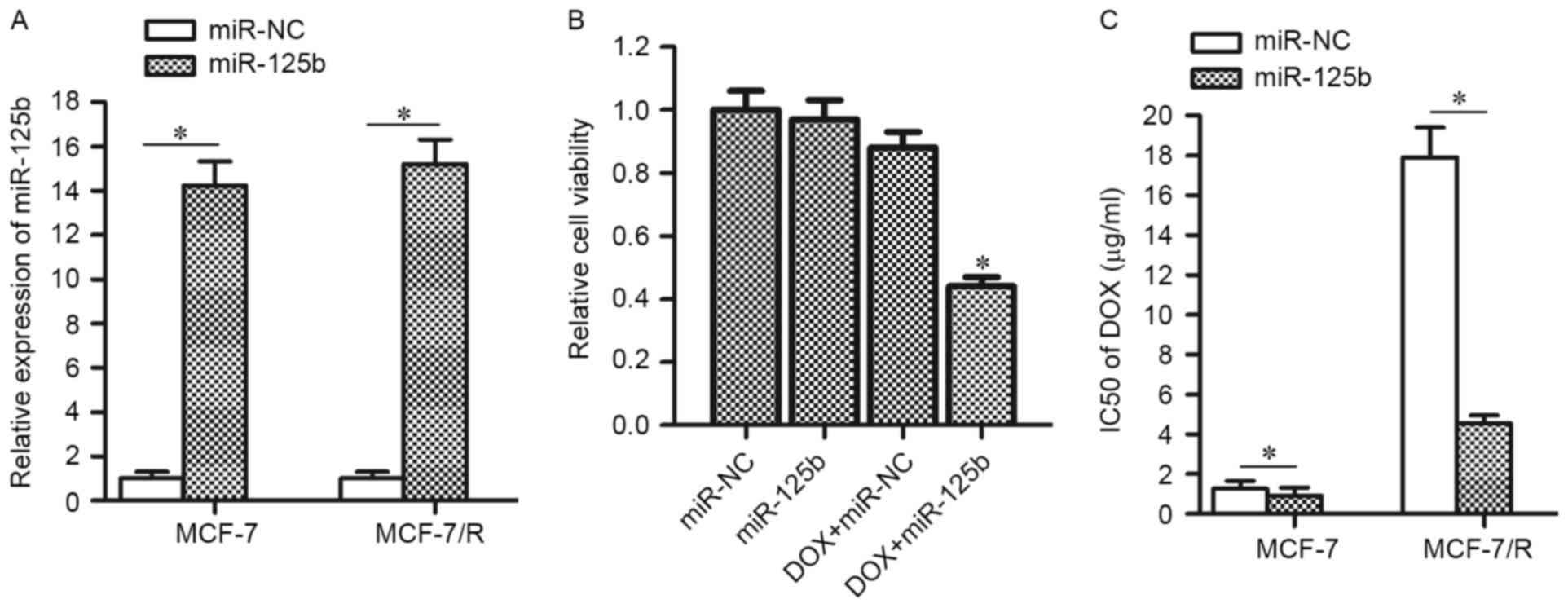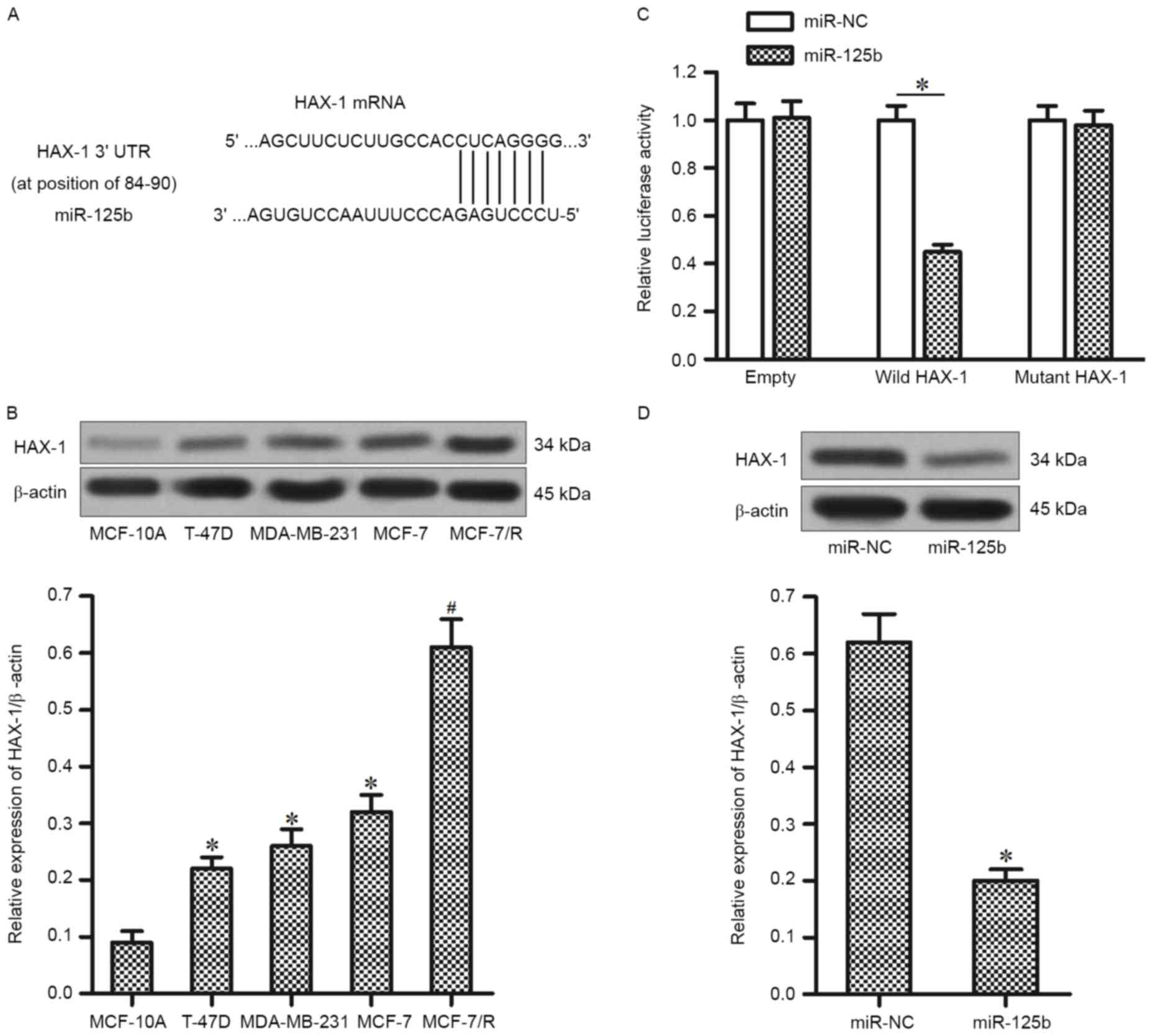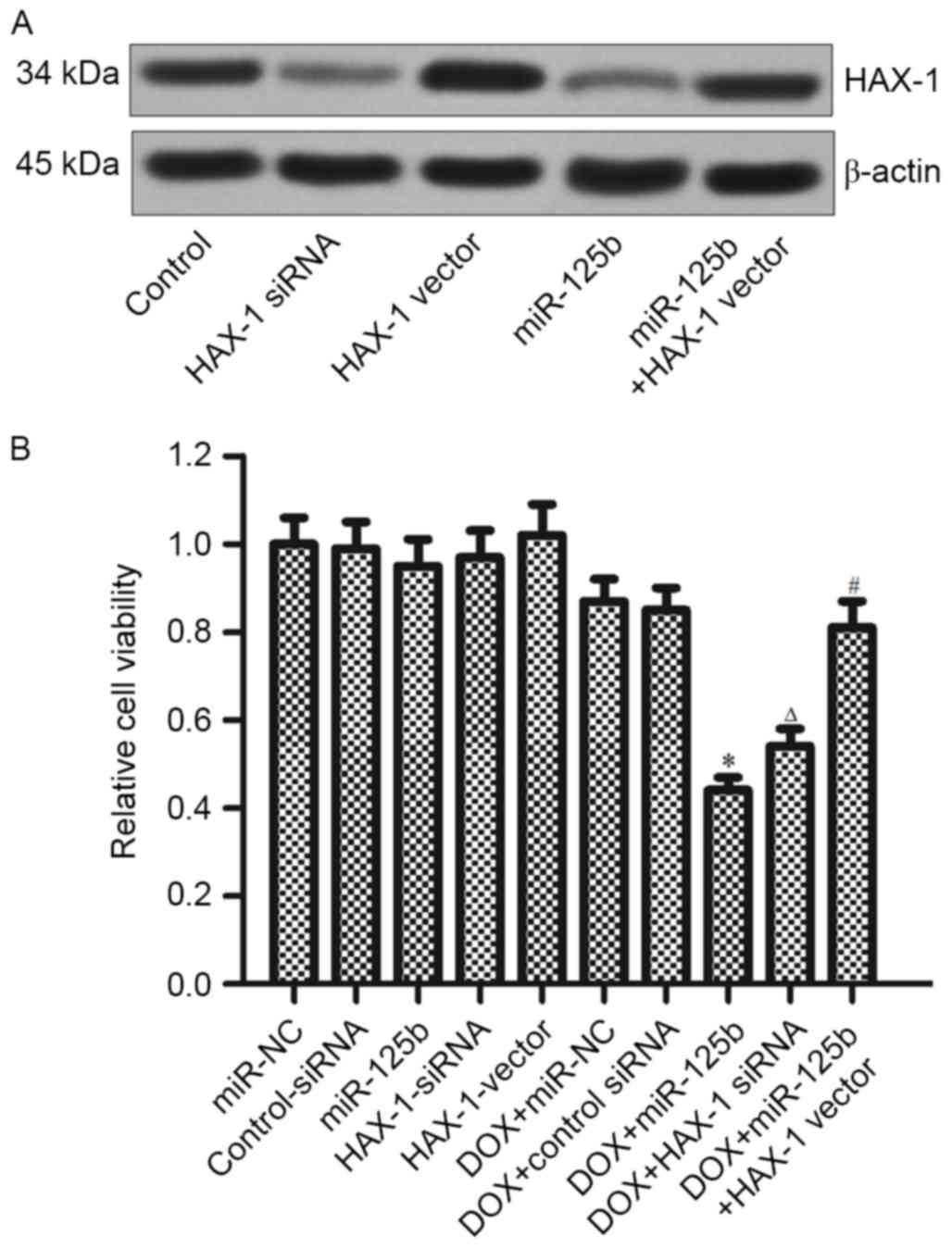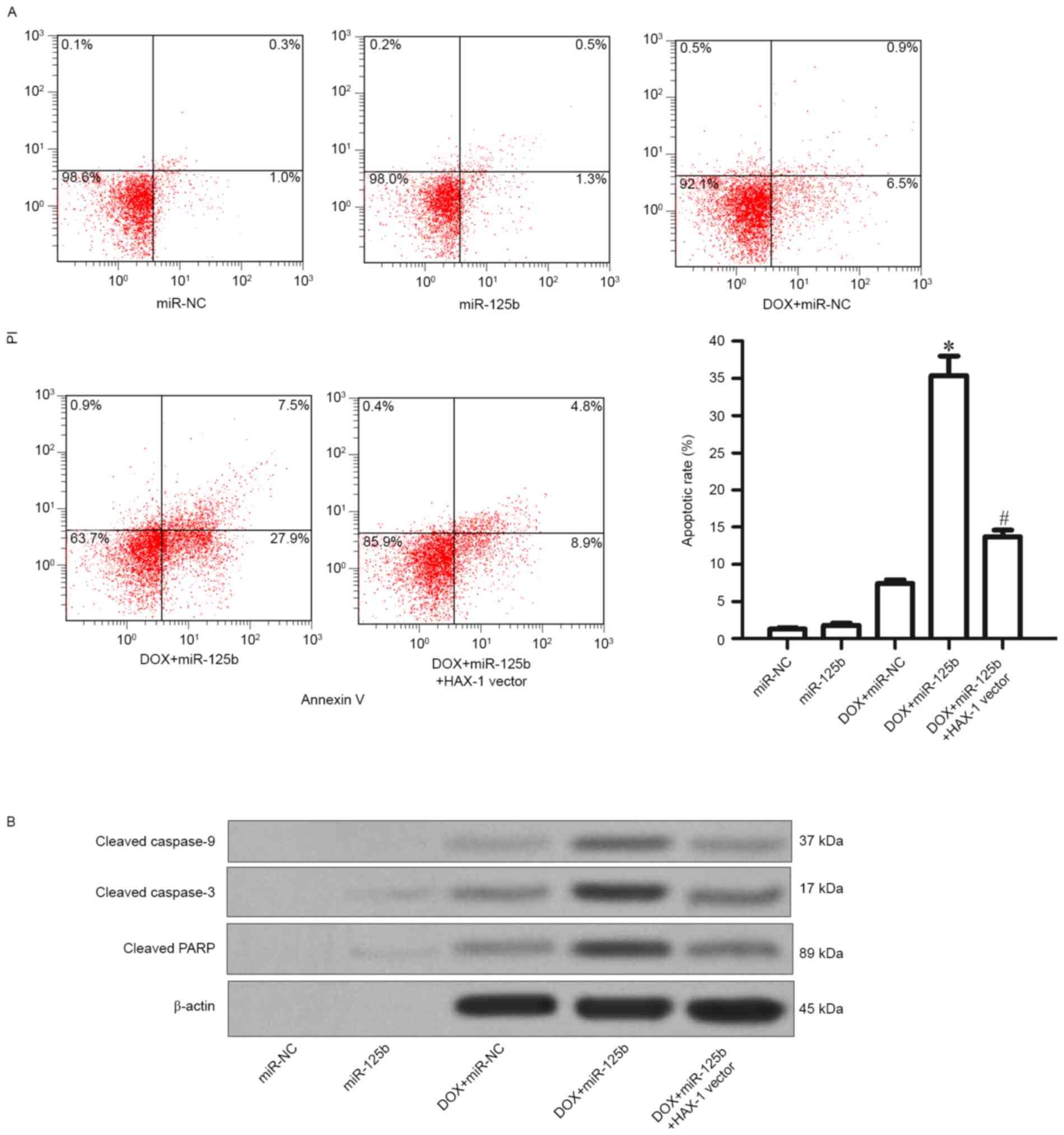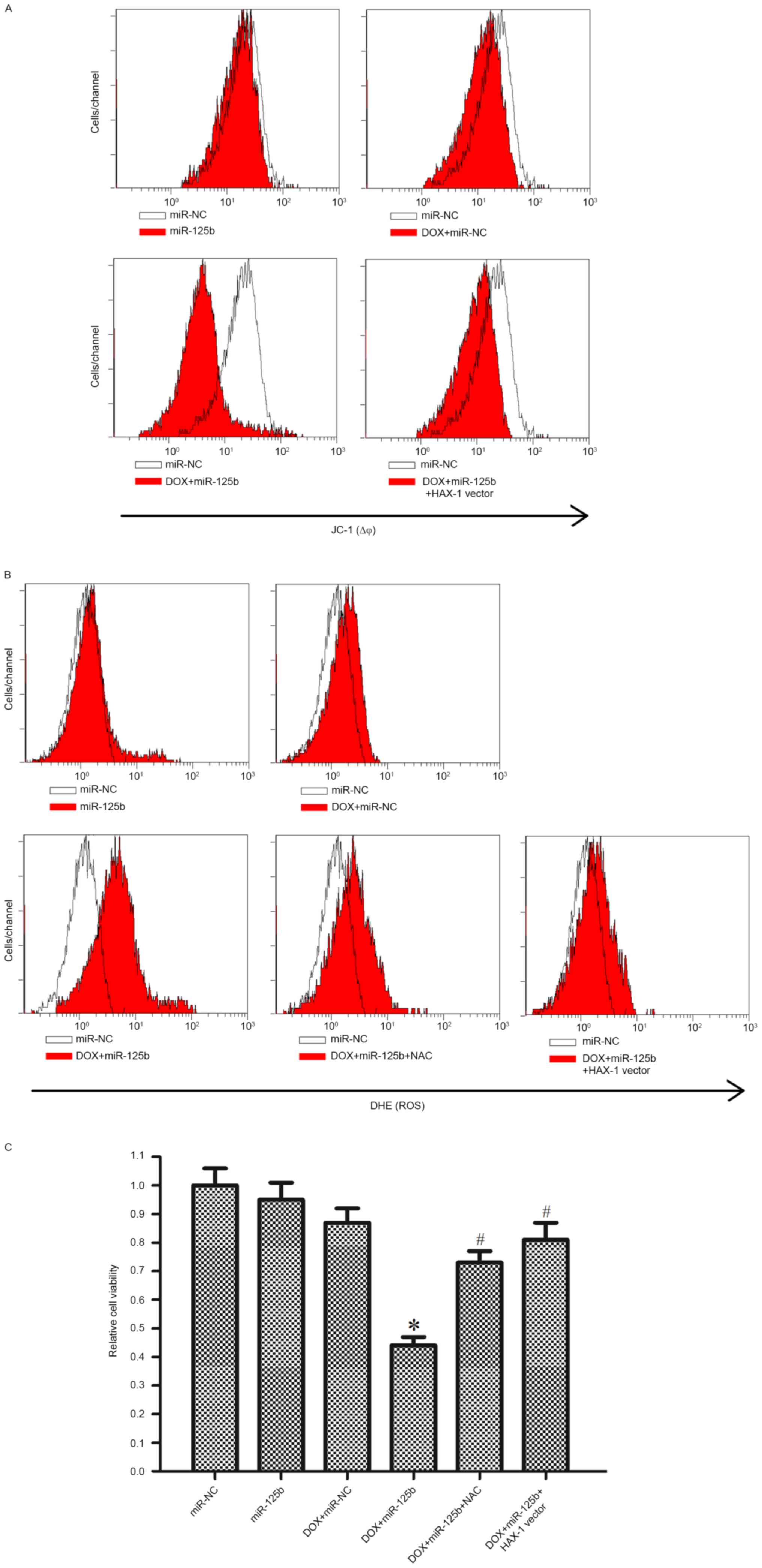miR‑125b regulates the drug‑resistance of breast cancer cells to doxorubicin by targeting HAX‑1
- Authors:
- Published online on: November 23, 2017 https://doi.org/10.3892/ol.2017.7476
- Pages: 1621-1629
-
Copyright: © Hu et al. This is an open access article distributed under the terms of Creative Commons Attribution License.
Abstract
Introduction
Breast cancer (BC) is the most common type of malignant cancer in the female population globally, resulting in the leading cause of cancer-associated mortality due to the metastatic spread of the cancer to vital organs (1). Therapy for primary breast cancer usually involves tumor resection, radiation therapy and chemotherapy. Surgery usually extends the survival of patients; however, for patients with the advanced stage of the disease, chemotherapy is considered as the alternative option (2). Unfortunately, systemic chemotherapy is usually ineffective due to the low sensitivity of cancer cells to chemotherapeutic drugs (3). Doxorubicin (DOX) is one type of antitumor antibiotic, which is widely used in multiple cancer types, including BC (4). The mechanism by which DOX kills the cancer cells is dependent on the apoptotic pathway, as DOX is able to embed into the DNA, and inhibit the synthesis of RNA and DNA, which is the initial signal of apoptosis (5). Despite the fact that DOX is widely used for the treatment of BC, the resistance of BC cells to the apoptotic pathway limits the clinical effectiveness of DOX (6,7). Therefore, there is a requirement to decrease DOX-resistance by enhancing the sensitivity of BC cells to apoptosis.
MicroRNAs (miRNAs) are endogenous, small non-coding RNAs with ~22 nucleotides in length. They are able to regulate various genes by binding to the 3′-untranslated region (3′-UTR) of their target mRNAs, leading to mRNA degradation or translational inhibition. As >30% of protein-coding genes are regulated by miRNAs, they are involved in various biological and pathological processes, including cell proliferation, metastasis, differentiation, and apoptosis (8–10). Studies have demonstrated that numerous miRNAs are dysregulated in BC (11,12). Therefore, the expression profiles of miRNAs have been investigated for the development of diagnostic biomarkers and therapeutic targets for the treatment of BC (11,12). Recently, studies have indicated that the dysregulation of miRNAs is associated with the sensitivity of cancer cells to chemotherapy. For example, miR-221 and miR-27a is usually dysregulated in breast cancer, which contributes to cisplatin resistance (13,14). However, the role and the mechanism of miRNAs in BC cell DOX-resistance remain unclear.
In the present study, the potential role of miR-125b in BC was investigated. The expression of miR-125b in tumor tissue samples from patients with BC were examined and it was demonstrated that miR-125b was downregulated in BC. Notably, it was revealed that the absence of miR-125b was involved in the development of DOX-resistance. These findings may provide a novel strategy for decreasing the resistance of chemotherapy in BC.
Materials and methods
Clinical specimens and cell lines
A total of 30 pairs of BC tumor and corresponding adjacent non-tumor tissues were obtained from patients who underwent tumor resection at Dongyang People's Hospital (Jinhua, China) between August 2013 and December 2015. All of the patients were female and the median age of the patients was 55 years (range, 32–78 years). The use of clinical tissues for the present study was approved by the Ethical Committee of Dongyang People's Hospital and all of the patients provided written informed consent. Human BC cell lines MCF-7, MDA-MB-231, T-47D and the human normal breast epithelial cell line MCF-10A were obtained from the Institute of Biochemistry and Cell Biology, Type Culture Collection of the Chinese Academy of Sciences (Shanghai, China). Cells were cultured at 37°C in Dulbecco's modified Eagle's medium (DMEM) supplemented with 10% fetal bovine serum (Gibco; Thermo Fisher Scientific, Inc., Waltham, MA, USA) in a humidified 5% CO2 incubator. To investigate the chemoresistance of BC, a DOX-resistant MCF-7 cell line (MCF-7/R) was established by stepwise exposure of MCF-7 cells to increasing concentrations of DOX (Sigma-Aldrich; Merck KGaA, Darmstadt, Germany). Briefly, the MCF-7 cells were initially treated with DOX at 0.2 µg/ml for 2 months and the DOX concentration was increased every 3 weeks by 0.04 µg/ml up to a final concentration of 0.6 µg/ml. To eliminate the influence of residual DOX in culture medium, the MCF-7/R cells were cultured in DOX-free DMEM for 3 weeks prior to the experiments.
Reverse transcription-quantitative polymerase chain reaction (RT-qPCR)
Total RNA was extracted from the tissues of patients with BC patients or BC cell lines in vitro using TRIzol® (Invitrogen; Thermo Fisher Scientific, Inc.). For analysis of miR-125b expression, the total RNA was reverse transcribed using stem-loop RT primers from the PrimeScript RT reagent kit according to the manufacturer's protocol (Takara Bio, Inc., Otsu, Japan). The miR-125b RT primer (Guangzhou RiboBio Co., Ltd., Guangzhou, China) had the following sequence: 5′-CTCAACTGGTGTCGTGGAGTCGGCAATTCAGTTGAGTCACAGGT-3′. qPCR was performed in triplicate using the SYBR Premix Ex Taq (Takara Bio, Inc.) on an ABI PRISM 7900 Sequence Detection system (Applied Biosystems). The relative expression of miR-125b was determined using the 2−ΔΔCq analysis method (15), whereby U6 snRNA was used as an internal reference. The PCR reaction mix consisted of 12.5 µl 2X SYBR® Premix Ex Taq II (cat no. RR820A; Takara Bio, Inc.), 1 µl forward primer (10 µM), 1 µl reverse primer (10 µM), 2 µl cDNA and 8.5 µl H2O. PCR was performed under the following thermocycling conditions: 95°C for 30 sec, followed by 40 cycles of 95°C for 5 sec and 60°C for 30 sec, and one cycle of 95°C for 15 sec, 60°C for 60 sec and 95°C for 15 sec for dissociation. PCR primers were obtained from Guangzhou RiboBio Co., Ltd. and had the following sequences: miR-125b forward, 5′-ACACTCCAGCTGGGTCCCTGAGACCCTTTAAC-3′ and reverse, 5′-TGGTGTCGTGGAGTCG-3′; and U6 forward, 5′-CTCGCTTCGGCAGCACA-3′ and reverse, 5′-AACGCTTCACGAATTTGCGT-3′.
Plasmid and transfection
For enforced expression of hematopoietic cell-specific protein 1-associated protein X-1 (HAX-1), the eukaryotic expression vector (pcDNA3.1 plasmid containing HAX-1 open reading frame; Invitrogen; Thermo Fisher Scientific, Inc.) was conducted. For transfection, 2 µg/ml HAX-1 vector, 50 pmol/ml miR-125b mimics (5′-AGUGUUCAAUCCCAGAGUCCCU-3′), 50 pmol/ml negative control oligonucleotide (miR-NC, 5′-AGUCAUCCGUACUCAGUGUCCA-3′), and 50 pmol/ml HAX-1 small interfering (si)RNA (forward 5′-GAGUGAUGCAAGAAGUGAAUU-3′, reverse 5′-UUCACUUCUUGCAUCACUCUU-3′) were transfected into the MCF-7 and MCF-7/R cells using Lipofectamine™ 2000 (Invitrogen; Thermo Fisher Scientific, Inc.) according to the manufacturer's protocol. All the RNA oligonucleotides were purchased from Shanghai GenePharma Co., Ltd. (Shanghai, China).
Luciferase reporter assay
Bioinformatics analysis using TargetScan (http://www.targetscan.org/) indicated that HAX-1 represents a target gene of miR-125b. To verify this, the wild-type of the putative miR-125b binding sites of HAX-1 3′-UTR were cloned into the downstream of firefly luciferase gene in the pMIR-REPORT™ miRNA Expression Reporter Vector (Thermo Fisher Scientific, Inc.) according to the manufacturer's protocol. To mutate the seed region of the miR-125b-binding sites (CUCAGGG to CUCUAGG), the QuikChange Site-Directed Mutagenesis kit (Agilent Technologies, Inc., Santa Clara, CA, USA) was used based on the wild-type conducted pMIR-REPORT™ vector following the manufacturer's protocol. To perform the luciferase reporter assay, the MCF-7/R cells were incubated in 48-well plates overnight at 37°C. The cells were then co-transfected with the wild-type (or mutant-type) of pMIR-REPORT vectors, Renilla luciferase pRL-TK vectors (Promega Corporation, Madison, WI, USA), and the miR-125b mimics using Lipofectamine 2000. After 48 h of transfection, the cells were collected and lysed using a lysis buffer provided by Promega Corporation (cat no. E1910). Luciferase activity was then measured using a Dual Luciferase Reporter Assay system according to the manufacturer's protocol (cat no. E1910, Promega Corporation). The relative Firefly luciferase activity was normalized to Renilla luciferase activity.
Western blot analysis
BC cells were lysed in the RIPA lysis buffer (Cell Signaling Technology, Inc., Danvers, MA, USA). A total of 50 µg total protein extracted from the lysed cells was separated by 12.5% SDS-PAGE and transferred to a polyvinylidene fluoride membrane (EMD Millipore, Billerica, MA, USA). Non-specific binding was blocked using 5% (w/v) skimmed milk in Tris-buffered saline with 1% Tween-20 for 2 h at room temperature. The membranes were then incubated with the primary antibodies mouse anti-HAX-1 monoclonal antibody (mAb) (cat. no. sc-166845; dilution, 1:1,000; Santa Cruz Biotechnology, Inc., Dallas, TX, USA), cleaved caspase-9 rabbit mAb (cat. no. 7237; dilution, 1:1,000; Cell Signaling Technology, Inc.), cleaved caspase-3 rabbit mAb (cat. no. 9661; dilution, 1:1,000; Cell Signaling Technology, Inc.), cleaved poly(ADP-ribose)polymerase (PARP) rabbit mAb (cat. no. 5625; dilution, 1:1,000; Cell Signaling Technology, Inc.) and β-actin rabbit mAb (cat. no. 4970; dilution, 1:1,000; Cell Signaling Technology, Inc.) overnight at 4°C. The membranes were then incubated with horseradish peroxidase (HRP)-conjugated goat anti-rabbit immunoglobulin G (IgG; cat no. 7074; dilution, 1:2,000; Cell Signaling Technology, Inc.) for detection of cleaved caspase-9, cleaved caspase-3, cleaved PARP and β-actin. Membranes with HAX-1 protein were probed by mouse IgGκ light chain binding protein conjugated with horseradish peroxidase (m-IgGκ BP-HRP, cat no. sc-516102; dilution, 1:2,000; Santa Cruz Biotechnology, Inc.). After 2 h incubation at 4°C, proteins were detected by using an enhanced chemiluminescence detection kit (Pierce; Thermo Fisher Scientific, Inc.).
Cell viability and the half maximal inhibitory concentration (IC50)
BC cells were seeded in 96-well plates at a density of 5×103 per well and transfected with RNAs and plasmids. Then, 24 h after transfection, the cells were treated with DOX for 48 h and the cell viability was evaluated using an MTT assay, in which dimethyl sulfoxide was used to dissolve the purple formazan (Sigma-Aldrich; Merck KGaA) (16). The absorbance was read at 570 nm using a microplate reader. The IC50 was calculated according to the cell viability curve.
Cell apoptosis detection
BC cells were collected after the 24 h transfection followed by the 48 h DOX treatment. The cells were then stained with Annexin V/propidium iodide (cat no. APOAF; Sigma-Aldrich; Merck KGaA) for 15 min at room temperature according to the manufacturer's protocols. Cell apoptosis was analyzed using a flow cytometer and FlowJo 10 software (FlowJo LLC, Ashland, OR, USA).
Measurement of mitochondrial membrane potential (MMP; ΔΨm) and reactive oxygen species (ROS)
BC cells were collected after the 24 h transfection followed by the 48 h DOX treatment. The MMP was detected using JC-1 (Molecular Probes; Thermo Fisher Scientific, Inc.) as the indicator (17) according to the manufacturer's protocol. Generation of ROS was measured using dihydroethidium (DHE; Molecular Probes; Thermo Fisher Scientific, Inc.) staining (18) according to the manufacturer's protocol. N-acetylcysteine (NAC; Sigma-Aldrich; Merck KGaA) was used as a ROS scavenger (18). The MMP and ROS were detected using a flow cytometer and analyzed using FlowJo 10 software (FlowJo LLC).
Statistical analysis
Data are represented as mean ± standard error obtained from three independent experiments. For comparison analysis, two-tailed Student's t-tests were used to estimate the statistical differences between two groups. One-way analysis of variance and Bonferroni's post hoc test were used to determine the differences between three or more groups. Statistical analysis was performed using SPSS 15.0 software (SPSS, Inc., Chicago, IL, USA). P<0.05 was considered to indicate a statistically significant difference.
Results
Downregulation of miR-125b is associated with DOX-resistance in BC
The expression of miR-125b was detected in the tumor tissues of 30 patients with BC and their adjacent normal tissues using RT-qPCR. As presented in Fig. 1A, the miR-125b levels were significantly downregulated in BC tissues compared with the corresponding normal tissues. Furthermore, the results in vitro demonstrated that the expression levels of miR-125b in BC cell lines (MCF-7, MDA-MB-231, and T-47D) were significantly higher compared with that in the normal breast epithelial cell line MCF-10A (Fig. 1B). These results suggest that miR-125b may function as a tumor suppressor in BC. To investigate chemoresistance in BC, a DOX-resistant MCF-7 cell line (MCF-7/R) was established. It was observed that the MCF-7/R cells were significantly resistant to the DOX treatment compared with their parental MCF-7 cells (Fig. 1C). To investigate the association between miR-125b and DOX-resistance, RT-qPCR analysis was performed in MCF-7 and MCF-7/R cells. Notably, the expression of miR-125b was significantly lower in MCF-7/R cells compared with that in the parental MCF-7 cells, suggesting the dysregulation of miR-125b is an important factor to promote the DOX-resistance in BC (Fig. 1D).
Enforced expression of miR-125b resensitizes MCF-7/R cells to DOX treatment
To confirm the hypothesis that the downregulation of miR-125b promotes DOX-resistance, MCF-7/R cells as well their parental MCF-7 cells were transfected with miR-125b mimics (the transfection efficiency is presented in Fig. 2A). In addition, as treatment with 4 µg/ml DOX induced slight cell death in MCF-7/R (Fig. 1C), this concentration of DOX was chosen for combination treatment with miR-125b mimics. As expected, transfection of miR-125b mimics was observed to significantly enhance the anti-tumor effect of DOX on MCF-7/R cells (Fig. 2B). Enforced expression of miR-125b decreased the IC50 of DOX by 74.6% in MCF-7/R cells and by 27.1% in MCF-7 cells (Fig. 2C). These results indicated that the DOX-resistant MCF-7 cells are more sensitive to miR-125b compared with the routine MCF-7 cells and enforced expression of miR-125b is able to resensitize the MCF-7/R cells to DOX treatment.
HAX-1 is the target of miR-125b in MCF-7/R
To investigate the target of miR-125b, which is associated with the DOX-resistance in MCF-7/R, the public database of TargetScan was used. It was demonstrated that the HAX-1 gene was a putative target of miR-125b (Fig. 3A). In accordance with this, the expression of HAX-1 was significantly higher in T-47D, MDA-MB-231 and MCF-7 BC cell lines compared with the MCF-10A cells. Furthermore, the expression level of HAX-1 was upregulated in MCF-7/R cells compared with that in the parental MCF-7 cells (Fig. 3B). Therefore, it was hypothesized that the HAX-1 is the target of miR-125b, its overexpression of which is responsible for inducing the DOX-resistance in MCF-7/R. To validate this, a luciferase reporter assay was performed to directly investigate whether HAX-1 was targeted by miR-125b. It was observed that the miR-125b mimics significantly decreased the luciferase activity of wild-HAX-1 reporter, but not the mutant or empty reporter (Fig. 3C). Furthermore, transfection of miR-125b significantly downregulated the protein level of HAX-1 in MCF-7/R cells (Fig. 3D). Taken together, these results suggest that HAX-1 is the target of miR-125b in DOX-resistant MCF-7 cells.
Enforced expression of miR-125b resensitizes MCF-7/R cells to DOX via downregulation of HAX-1
To confirm whether miR-125b regulates the DOX-resistance via targeting the HAX-1, MCF-7/R cells were transfected with HAX-1 siRNA, HAX-1 vector and miR-125b mimics (the transfection efficiency is presented in Fig. 4A). It was demonstrated that HAX-1 siRNA serves a similar role with the miR-125b in promoting DOX-induced cell death. However, overexpression of HAX-1 significantly decreased the cytotoxicity in the combination treatment of DOX+miR-125b (Fig. 4B). These results indicated that the miR-125b/HAX-1 signaling pathway regulates the DOX-resistance in BC.
miR-125b promotes DOX-induced cell death through caspase-dependent apoptosis in MCF-7/R cells
As the aforementioned results demonstrated that the downregulation of HAX-1 is essential for reversing DOX-resistance in MCF-7/R cells, the effect of the combination with DOX and miR-125b on the cell death pathway was next investigated. As presented in Fig. 5A, it was observed that although the DOX alone treatment induced apoptosis slightly in MCF-7/R cells, the combination with miR-125b promoted the DOX-induced apoptosis significantly (Fig. 5A). Furthermore, it was revealed that the combination of DOX and miR-125b resulted in significant activation of caspase-9, caspase-3 and their substrate PARP, in addition, the activation of caspase activity was significantly impaired by the HAX-1 vector (Fig. 5B). Thus, it was demonstrated that miR-125b promotes DOX-induced apoptosis through the caspase-dependent signaling pathway by targeting HAX-1.
miR-125b-promoted apoptosis is dependent on the HAX-1-MMP-ROS signaling pathway
Previous reports have indicated that HAX-1 is an important regulator for the mitochondrial pathway of apoptosis (19). Therefore, the role of the mitochondrial pathway in miR-125b-promoted apoptosis was investigated. As presented in Fig. 6A, it was demonstrated that although miR-125b alone did not influence the MMP of MCF-7/R cells, miR-125b significantly promoted DOX-induced mitochondrial damage. Furthermore, the effect of miR-125b on mitochondria was inhibited by the HAX-1 vector. Previous studies have indicated that the generation of ROS may be induced by the mitochondrial dysfunction. Thus, ROS generation was assessed by DHE staining using a previously descried method (18,20). It was observed that miR-125b significantly promoted the generation of ROS induced by DOX treatment. Notably, the HAX-1 vector and NAC, a scavenger of ROS (18), inhibited ROS generation, indicating the important role of HAX-1 in the mitochondrial pathway of DOX-based treatment in MCF-7/R cells (Fig. 6B). Furthermore, the HAX-1 vector and NAC significantly inhibited DOX- and miR-125b-induced cell death in MCF-7/R cells (Fig. 6C). Taken together, this data suggested that miR-125b promoted DOX-induced apoptosis through the HAX-1-MMP-ROS pathway.
Discussion
An increasing number of studies have demonstrated that miR-125b acts as a tumor suppressor in multiple cancer types. Zhao et al (21) demonstrated that the expression of miR-125b in tumor tissues is lower compared with that in adjacent normal tissues. Furthermore, the overexpression of miR-125b inhibited cell proliferation, migration and caused cell cycle arrest in G1 phase in bladder cancer (21). In ovarian cancer cells, miR-125b was reported to suppress tumor invasion and migration by targeting eukaryotic translation initiation factor 4E binding protein 1 (22). The present study demonstrated that miR-125b was significantly downregulated in the tumor tissues of patients with BC and BC cell lines, when compared with adjacent non-tumor, and normal MCF-10A cells, respectively. Furthermore, it was revealed that the MCF-7 cells exhibited a more extensive decline in miR-125b expression when they became DOX-resistance. Therefore, we hypothesized that miR-125b is a tumor suppressor in BC.
Previously, studies have confirmed that the dysregulation of miRNAs is associated with the curative effect of chemotherapy in cancer. For example, miR-193b which is downregulated in HCC has been demonstrated to be essential for cisplatin-induced apoptosis (23). The knockdown of miR-155 is able to reverse DOX-resistance in lung cancer (24). Overexpression of miR-125b in chondrosarcoma cells inhibits cell growth rates and increases the sensitivity of cells to DOX (25). To investigate chemoresistance in BC, a DOX-resistant MCF-7 cell line was established. Several reports have demonstrated that P-glycoprotein, which leads to drug efflux, is overexpressed and mediates drug-resistance in chemoresistant BC cells (26). However, in the current study, it was revealed that the miRNA dysregulation also mediated chemoresistance. To investigate whether or not downregulated miR-125b was associated the chemoresistance, the MCF-7/R cells were treated with DOX in the presence or absence of miR-125b mimics. It was observed that the combination with miR-125b significantly decreased the IC50 of DOX in MCF-7/R cells. Therefore, the role of miR-125b in reversing DOX-resistance was demonstrated.
HAX-1 is an important anti-apoptotic protein, which is located on the mitochondrial outer membrane (27). Previous studies have reported that the overexpression of HAX-1 impedes apoptosis of cancer cells, resulting from the protection of mitochondria from damage induced by drugs and environmental factors (28). Therefore, numerous malignancies exhibit a high level of HAX-1, including BC (29). In the present study, HAX-1 was identified as a target of miR-125b and the promotion of miR-125b mimics on DOX-induced cell death is dependent on the downregulation of HAX-1 in MCF-7/R cells.
As HAX-1 is an apoptosis-associated protein, the results of the current study revealed that the overexpression of miR-125b reversed DOX-resistance and promoted DOX-induced apoptosis through the HAX-1 signaling pathway. To further explore the underlying mechanisms, the MMP was measured, which is the downstream of HAX-1 signaling. The results indicated that miR-125b-induced inhibition of HAX-1 promoted the DOX to damage the mitochondria. In combination with miR-125b and DOX, HAX-1 induced a decrease in the MMP, which was responsible for the release of mitochondrial components into the cytoplasm (30). Among these components, ROS is a key inducer of mitochondrial apoptosis (20). In the current study, it was observed that the elimination of ROS by NAC inhibited cell death induced by the combination of miR-125b and DOX in MCF-7/R cells. This suggests that the overexpression of miR-125b resensitizes the MCF-7/R cells to DOX through the mitochondrial-ROS pathway.
In summary, the present study demonstrates that miR-125b acts as a tumor suppressor in BC. Additionally, the absence of miR-125b may be essential for developing DOX-resistance in BC. miR-125b/HAX-1-targeted therapy may be considered as a novel strategy for reversing the resistance of cancer cells to DOX treatment.
References
|
Siegel R, Naishadham D and Jemal A: Cancer statistics, 2013. CA Cancer J Clin. 63:11–30. 2013. View Article : Google Scholar : PubMed/NCBI | |
|
Du XL, Key CR, Osborne C, Mahnken JD and Goodwin JS: Discrepancy between consensus recommendations and actual community use of adjuvant chemotherapy in women with breast cancer. Ann Intern Med. 138:90–97. 2003. View Article : Google Scholar : PubMed/NCBI | |
|
Chen YY, Li ZZ, Ye YY, Xu F, Niu RJ, Zhang HC, Zhang YJ, Liu YB and Han BS: Knockdown of SALL4 inhibits the proliferation and reverses the resistance of MCF-7/ADR cells to doxorubicin hydrochloride. BMC Mol Biol. 17:62016. View Article : Google Scholar : PubMed/NCBI | |
|
Wang H, Yu Y, Jiang Z, Cao WM, Wang Z, Dou J, Zhao Y, Cui Y and Zhang H: Next-generation proteasome inhibitor MLN9708 sensitizes breast cancer cells to doxorubicin-induced apoptosis. Sci Rep. 6:264562016. View Article : Google Scholar : PubMed/NCBI | |
|
Chen NT, Wu CY, Chung CY, Hwu Y, Cheng SH, Mou CY and Lo LW: Probing the dynamics of doxorubicin-DNA intercalation during the initial activation of apoptosis by fluorescence lifetime imaging microscopy (FLIM). PLoS One. 7:e449472012. View Article : Google Scholar : PubMed/NCBI | |
|
Zheng Y, Lv X, Wang X, Wang B, Shao X, Huang Y, Shi L, Chen Z, Huang J and Huang P: MiR-181b promotes chemoresistance in breast cancer by regulating Bim expression. Oncol Rep. 35:683–690. 2016. View Article : Google Scholar : PubMed/NCBI | |
|
Chakravarty G, Mathur A, Mallade P, Gerlach S, Willis J, Datta A, Srivastav S, Abdel-Mageed AB and Mondal D: Nelfinavir targets multiple drug resistance mechanisms to increase the efficacy of doxorubicin in MCF-7/Dox breast cancer cells. Biochimie. 124:53–64. 2016. View Article : Google Scholar : PubMed/NCBI | |
|
Ambros V: MicroRNA pathways in flies and worms: Growth, death, fat, stress, and timing. Cell. 113:673–676. 2003. View Article : Google Scholar : PubMed/NCBI | |
|
Bartel DP: MicroRNAs: Target recognition and regulatory functions. Cell. 136:215–233. 2009. View Article : Google Scholar : PubMed/NCBI | |
|
Bartel DP: MicroRNAs: Genomics, biogenesis, mechanism, and function. Cell. 116:281–297. 2004. View Article : Google Scholar : PubMed/NCBI | |
|
Tan YY, Xu XY, Wang JF, Zhang CW and Zhang SC: MiR-654-5p attenuates breast cancer progression by targeting EPSTI1. Am J Cancer Res. 6:522–532. 2016.PubMed/NCBI | |
|
Gu X, Xue JQ, Han SJ, Qian SY and Zhang WH: Circulating microRNA-451 as a predictor of resistance to neoadjuvant chemotherapy in breast cancer. Cancer Biomark. 16:395–403. 2016. View Article : Google Scholar : PubMed/NCBI | |
|
Ye Z, Hao R, Cai Y, Wang X and Huang G: Knockdown of miR-221 promotes the cisplatin-inducing apoptosis by targeting the BIM-Bax/Bak axis in breast cancer. Tumour Biol. 37:4509–4515. 2016. View Article : Google Scholar : PubMed/NCBI | |
|
Zhou S, Huang Q, Zheng S, Lin K, You J and Zhang X: miR-27a regulates the sensitivity of breast cancer cells to cisplatin treatment via BAK-SMAC/DIABLO-XIAP axis. Tumour Biol. 37:6837–6845. 2016. View Article : Google Scholar : PubMed/NCBI | |
|
Livak KJ and Schmittgen TD: Analysis of relative gene expression data using real-time quantitative PCR and the 2(-Delta Delta C(T)) method. Methods. 25:402–408. 2001. View Article : Google Scholar : PubMed/NCBI | |
|
Wang J, Tian X, Han R, Zhang X, Wang X, Shen H, Xue L, Liu Y, Yan X, Shen J, et al: Downregulation of miR-486-5p contributes to tumor progression and metastasis by targeting protumorigenic ARHGAP5 in lung cancer. Oncogene. 33:1181–1189. 2014. View Article : Google Scholar : PubMed/NCBI | |
|
Prathapan A, Vineetha VP and Raghu KG: Protective effect of Boerhaavia diffusa L. against mitochondrial dysfunction in angiotensin II induced hypertrophy in H9c2 cardiomyoblast cells. PLoS One. 9:e962202014. View Article : Google Scholar : PubMed/NCBI | |
|
Duan W, Jin X, Li Q, Tashiro S, Onodera S and Ikejima T: Silibinin induced autophagic and apoptotic cell death in HT1080 cells through a reactive oxygen species pathway. J Pharmacol Sci. 113:48–56. 2010. View Article : Google Scholar : PubMed/NCBI | |
|
Radhika V, Onesime D, Ha JH and Dhanasekaran N: Galpha13 stimulates cell migration through cortactin-interacting protein Hax-1. J Biol Chem. 279:49406–49413. 2004. View Article : Google Scholar : PubMed/NCBI | |
|
Zorov DB, Juhaszova M and Sollott SJ: Mitochondrial reactive oxygen species (ROS) and ROS-induced ROS release. Physiol Rev. 94:909–950. 2014. View Article : Google Scholar : PubMed/NCBI | |
|
Zhao X, He W, Li J, Huang S, Wan X, Luo H and Wu D: MiRNA-125b inhibits proliferation and migration by targeting SphK1 in bladder cancer. Am J Transl Res. 7:2346–2354. 2015.PubMed/NCBI | |
|
Lee M, Kim EJ and Jeon MJ: MicroRNAs 125a and 125b inhibit ovarian cancer cells through post-transcriptional inactivation of EIF4EBP1. Oncotarget. 7:8726–8742. 2016. View Article : Google Scholar : PubMed/NCBI | |
|
Yin W, Nie Y, Zhang Z, Xie L and He X: miR-193b acts as a doxorubicin sensitizer via the caspase-3-dependent pathway in HCC chemotherapy. Oncol Rep. 34:368–3674. 2015. View Article : Google Scholar : PubMed/NCBI | |
|
Lv L, An X, Li H and Ma L: Effect of miR-155 knockdown on the reversal of doxorubicin resistance in human lung cancer A549/dox cells. Oncol Lett. 11:1161–1166. 2016.PubMed/NCBI | |
|
Tang XY, Zheng W, Ding M, Guo KJ, Yuan F, Feng H, Deng B, Sun W, Hou Y and Gao L: miR-125b acts as a tumor suppressor in chondrosarcoma cells by the sensitization to doxorubicin through direct targeting the ErbB2-regulated glucose metabolism. Drug Des Devel Ther. 10:571–583. 2016.PubMed/NCBI | |
|
Clarke R, Leonessa F and Trock B: Multidrug resistance/P-glycoprotein and breast cancer: Review and meta-analysis. Semin Oncol. 32(6 Supp 7): S9–S15. 2005. View Article : Google Scholar : PubMed/NCBI | |
|
Suzuki Y, Demoliere C, Kitamura D, Takeshita H, Deuschle U and Watanabe T: HAX-1, a novel intracellular protein, localized on mitochondria, directly associates with HS1, a substrate of Src family tyrosine kinases. J Immunol. 158:2736–2744. 1997.PubMed/NCBI | |
|
Trebinska A, Högstrand K, Grandien A, Grzybowska EA and Fadeel B: Exploring the anti-apoptotic role of HAX-1 versus BCL-XL in cytokine-dependent bone marrow-derived cells from mice. FEBS Lett. 588:2921–2927. 2014. View Article : Google Scholar : PubMed/NCBI | |
|
Trebinska A, Rembiszewska A, Ciosek K, Ptaszynski K, Rowinski S, Kupryjanczyk J, Siedlecki JA and Grzybowska EA: HAX-1 overexpression, splicing and cellular localization in tumors. BMC Cancer. 10:762010. View Article : Google Scholar : PubMed/NCBI | |
|
Halestrap AP, Clarke SJ and Javadov SA: Mitochondrial permeability transition pore opening during myocardial reperfusion-a target for cardioprotection. Cardiovasc Res. 61:372–385. 2004. View Article : Google Scholar : PubMed/NCBI |



